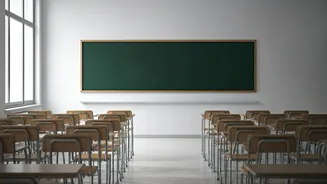Divided Learning Spaces
The Indian education system is undergoing a significant transformation, and it has become increasingly polarised. It's crucial to understand that this
isn't limited to classrooms; it extends to broader societal divisions. Various factors play a role in this trend. These elements include the impact of social media, biased news reports, and differing ideologies among parents, teachers, and students. These viewpoints often clash, which create tension in schools and affect how students perceive each other and the world. In addition, the way the curriculum is designed, and the topics chosen for discussion can also be divisive. Furthermore, the political environment influences the atmosphere in educational institutions, potentially favouring certain groups or viewpoints over others. This can create feelings of exclusion or marginalisation among students who may not align with the dominant perspective.
Impact on Students
The effects of polarisation on students are profound and multifaceted. Exposure to conflicting views in the classroom can cause anxiety. This anxiety creates tension and a lack of emotional safety. It can also restrict students from openly expressing their views, fearing negative consequences or bullying. Furthermore, polarisation hinders critical thinking skills, as students become more likely to stick to their existing beliefs and dismiss opposing viewpoints. The ability to have respectful conversations and understanding diverse perspectives is crucial for students. As a result of polarisation, this type of dialogue is often difficult to attain. It is important to address these issues to ensure that Indian classrooms remain places where students can engage in healthy debates and learn about the world.
Teachers' Dilemma
Teachers are facing a challenging environment due to increased polarisation. They are at the forefront of managing discussions in the classroom, and they often face pressures. Teachers must remain neutral while teaching sensitive topics, such as history, politics, and culture. This requires a fine balance between providing different perspectives and not promoting particular viewpoints. Teachers are constantly under scrutiny, and their actions can be misconstrued. When they navigate controversial subjects, they may face criticism from parents, administrators, or community members. Furthermore, educators often lack training and resources on how to effectively manage polarised discussions. Consequently, they struggle to create an inclusive and safe learning environment for all students. The role of teachers has changed in the face of such challenges.
Curriculum Challenges
The curriculum also plays a significant role in classroom polarisation. Textbook selection and content development become extremely important. Curricula that emphasize certain ideologies can strengthen existing biases and exacerbate polarisation. Topics such as history or social issues can be presented from multiple angles, but they are often presented from a singular perspective. This narrow approach does not promote a well-rounded understanding. In addition, the lack of diversity in curriculum materials can lead to exclusion, particularly for students from minority communities. The emphasis on specific cultural narratives also creates feelings of marginalisation. These situations further fuel polarisation. A more inclusive curriculum, which explores diverse viewpoints, is vital to improve education.
Finding Solutions
Various solutions are needed to address the impact of polarisation. Promoting dialogue and critical thinking is crucial. Schools can conduct workshops to improve communication and critical evaluation skills. Teachers need to be equipped with professional training. They must learn methods for managing polarised discussions effectively. Furthermore, it is important to encourage schools to promote diversity and inclusion. This includes representing diverse viewpoints, and integrating multicultural content in the curriculum. Engaging parents and the community is also vital. Open communication channels between schools and parents can help to foster understanding. By taking these steps, Indian classrooms can be transformed into places where students feel safe.







